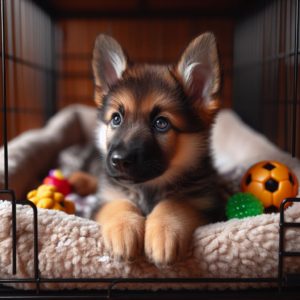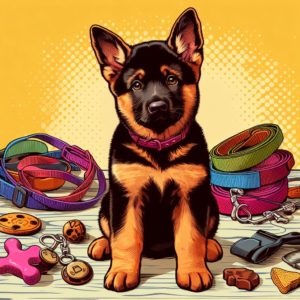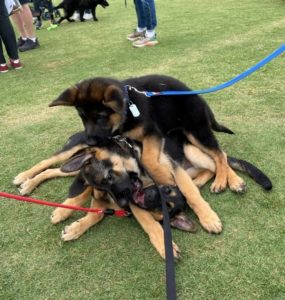How to Clip a German Shepherd’s Toe Nails: A Comprehensive Guide
German Shepherds are magnificent dogs known for their intelligence, loyalty, and athleticism. Proper grooming, including regular nail trims, is an essential part of their care routine. Clipping a German Shepherd’s toenails can seem like a daunting task, but with the right tools, techniques, and early training, it can become a stress-free experience for both you and your furry friend. In this comprehensive guide, we will walk you through the steps of clipping a German Shepherd’s toenails, starting from their puppyhood, and provide you with valuable tips and information.
Importance of Clipping German Shepherd’s Toe Nails
Trimming your German Shepherd’s nails is crucial for their overall health and well-being. Overgrown nails can cause discomfort, pain, and even health issues. Long nails can affect their gait and posture, leading to joint problems and potential injuries. Regular nail trims also help prevent scratching and accidental damage to furniture, flooring, and family members.
Early Training and Getting Them Used to Touching Feet
Start getting your German Shepherd puppy accustomed to having their feet touched from an early age. Frequent handling of their paws, including gently touching and massaging their toes, will help them build a positive association with their feet being touched. Offer treats and praise during these sessions to reinforce positive behavior. Gradually introduce the sound and sensation of nail clippers or a grinder, even if you are not actually trimming their nails yet. This desensitization process will make nail trims more comfortable for your German Shepherd as they grow.
Tools Needed for Nail Clipping
Before you start clipping your German Shepherd’s toenails, gather the following tools:
- Nail Clippers: Choose a high-quality pair of nail clippers specifically designed for dogs. There are two main types: guillotine-style clippers and scissor-style clippers. Experiment with both to see which you and your German Shepherd are most comfortable using.
- Nail Grinder (Optional): A nail grinder is an alternative to clippers. It files down the nails gradually, reducing the chance of accidentally cutting the quick—the sensitive part inside the nail. Grinders are especially useful for dogs with dark nails, where it’s challenging to see the quick.
- Styptic Powder: In case you accidentally clip too far and cause bleeding, the styptic powder helps stop the bleeding quickly. It’s a must-have for any nail-trimming session.
- Treats: Prepare some tasty treats to reward your German Shepherd during and after the nail clipping process. Positive reinforcement will help keep them calm and make the experience more enjoyable.
Steps to Clip a German Shepherd’s Toe Nails
Follow these steps to safely clip your German Shepherd’s toenails:
- Choose the Right Environment: Find a quiet and well-lit area where you and your German Shepherd can comfortably focus on the task at hand. Consider using a non-slip surface, such as a rubber mat, to prevent any accidents.
- Stay Calm and Relaxed: Dogs can sense your energy, so it’s important to remain calm and relaxed throughout the nail trimming process. Take deep breaths and speak to your German Shepherd in a soothing tone to keep them at ease.
- Inspect the Nails: Examine your German Shepherd’s nails and identify the quick—pink part inside the nail. Be cautious not to cut into the quick, as it is sensitive and can cause bleeding and pain. Trim small amounts at a time to avoid any accidents.
- Proper Nail Clipping Technique: Hold your German Shepherd’s paw gently but firmly. If using guillotine-style clippers, position them around the nail, making sure to leave a small distance from the quick. Squeeze the handles to cut the nail in one quick motion. If using scissor-style clippers, position them perpendicular to the nail and make a straight cut. Take breaks between each nail to give your German Shepherd a chance to relax.
- Reward and Praise: After successfully trimming a nail, reward your German Shepherd with a treat and praise. This positive reinforcement will help them associate nail trims with positive experiences.
- Monitor and Repeat: Regularly inspect your German Shepherd’s nails to determine when they need trimming again. Aim to clip their nails every two to four weeks, depending on their growth rate. By repeating the process regularly, your German Shepherd will become more accustomed to nail trims over time.
Final Tips and Considerations
If your German Shepherd has especially long or dark nails, consider using a nail grinder instead of clippers. Grinding allows for gradual, controlled trimming and reduces the risk of cutting the quick.
- If you accidentally cut the quick and cause bleeding, apply styptic powder to the nail immediately to stop the bleeding. Applying gentle pressure with a clean cloth or tissue can also help.
- If you’re unsure about trimming your German Shepherd’s nails or feel uncomfortable doing it yourself, consult a professional groomer or a veterinarian. They can provide guidance and demonstrate the proper technique.
- Regular exercise and outdoor activities can naturally wear down your German Shepherd’s nails to some extent. However, they still require occasional trims to maintain optimal length.
- Take breaks during the nail trimming process if you or your German Shepherd start to feel overwhelmed or stressed. It’s important to prioritize their comfort and well-being.
- Remember, patience and consistency are key. With time and practice, nail trims will become easier for both you and your German Shepherd.
Clipping a German Shepherd’s toenails is an essential part of their grooming routine. By following the steps outlined in this comprehensive guide and providing early training, you can ensure a stress-free and positive experience for your furry companion. Regular nail trims will keep your German Shepherd healthy, comfortable, and happy.
Crate Training German Shepherd Puppies: A Guide To A Happy And Well-Behaved Companion
Crate Training German Shepherd Puppies
Introduction
Crate training is an essential and effective method for teaching German Shepherd puppies proper behaviour and providing them with a safe and comfortable space. German Shepherds are intelligent and highly trainable dogs, and crate training can help establish a routine, promote good behaviour, and ensure their well-being. In this comprehensive guide, we will delve into the ins and outs of crate training for German Shepherd puppies, providing you with valuable insights and tips for a successful training journey.
Why Crate Training?
**Establishing a Safe Space
Crate training offers your German Shepherd puppy a designated area that they can call their own. This space becomes their den, a secure and cozy retreat where they can relax, sleep, and feel protected.
**Promoting Good Behaviour
By crate training, you can teach your German Shepherd puppy proper behaviours and boundaries. The crate serves as a tool for housebreaking, preventing destructive chewing, and reducing separation anxiety.
**Facilitating Travel and Vet Visits
Crate training also comes in handy when traveling with your German Shepherd or taking them to the vet. A crate-trained puppy will feel more comfortable and secure during these situations, making it easier for both of you.
Getting Started with Crate Training
**Choosing the Right Crate
Selecting an appropriately sized crate is crucial for your German Shepherd puppy’s comfort and safety. The crate should be large enough for them to stand, turn around, and lie down comfortably, but not so spacious that it allows for accidents or excessive movement.
**Introducing the Crate
To introduce the crate to your German Shepherd puppy, make it a positive and welcoming environment. Place soft bedding, toys, and treats inside the crate to create a pleasant association. Encourage your puppy to explore the crate at their own pace, without forcing them.
**Gradual Crate Training
Start by having short sessions where your puppy voluntarily enters the crate. Use treats and positive reinforcement to encourage them to enter and stay inside. Gradually increase the duration of crate time, always rewarding good behaviour and providing comfort.
**Establishing a Routine
Consistency is key when crate training your German Shepherd puppy. Establish a regular schedule for feeding, exercise, and crate time. This routine helps them understand when it’s time to relax and when it’s time to play, making the training process smoother.
Crate Training Tips
**Patience and Positive Reinforcement
Remember to be patient with your German Shepherd puppy during crate training. They may initially resist or feel anxious about being confined. Use positive reinforcement techniques, such as praise, treats, and toys, to create a positive association with the crate.
**Gradual Alone Time
Once your puppy is comfortable spending time in the crate with you nearby, gradually increase the duration of alone time. Start by leaving the room for a few minutes, then gradually extend the duration. This helps your puppy develop independence and reduces separation anxiety.
**Avoid Using the Crate as Punishment
It’s essential to maintain a positive association with the crate. Never use it as a form of punishment for your German Shepherd puppy. The crate should always be seen as a safe and comfortable space, not a place of confinement or isolation.
**Exercise and Mental Stimulation
German Shepherds are active and intelligent dogs that require both physical and mental stimulation. Make sure to provide plenty of exercise and mental enrichment activities outside of crate time. A tired and mentally stimulated puppy is more likely to settle down and relax in the crate.
**Gradual Expansion of Space
As your German Shepherd puppy grows and becomes more comfortable with crate training, you can gradually expand the space they have access to. This can be done by using crate dividers or transitioning to a larger crate. However, always ensure that the crate remains an appropriate size for your puppy’s comfort and safety.
Conclusion
Crate training German Shepherd puppies is an effective method for establishing good behaviour, providing a safe space, and facilitating travel and vet visits. By following the tips and guidelines in this guide, you can ensure a successful crate training experience for both you and your furry companion. Remember, patience, consistency, and positive reinforcement are key to creating a happy and well-behaved German Shepherd puppy. Happy training!
German Shepherd Puppy-What to Expect-1st Time Puppy Owner’s Perspective!
When my husband and I brought home our gorgeous fluffy German Shepherd puppy Koda, we knew our lives would be forever changed. But after just one month with this rambunctious ball of fur, we realised we had no idea what we were in for!
I’ll never forget the day we picked eight-week-old Koda up from the breeder. He was so tiny, just 7 kilos, with massive paws that made him look like the Big Bad Wolf in disguise. His ears flopped over like a hound dog’s, only adding to his irresistible puppy charm. My heart melted instantly for this beautiful puppy.
Fast forward four short weeks and it’s amazing how much Koda has grown. He’s nearly doubled in size to 14 kilos and those signature German Shepherd ears now stand tall. I swear he’s stretching longer by the hour!
Potty Training
Of course, Koda’s rapid growth has come with its fair share of challenges. Potty training a German Shepherd puppy is no easy task! Though intelligent, Koda’s curiosity and energy mean his bladder is no match for this big world waiting to be explored. We started taking him out every 30-60 minutes, praising him like crazy, and treating him whenever he went outside. Accidents inside were met with calm redirection back to his potty spot to try again. I can’t even count how many towels and carpet cleaners we’ve gone through! But after three long weeks, something finally clicked for clever Koda.
Landshark Phase
And don’t even get me started on the Landshark phase. Those needle-sharp puppy teeth were vicious! Having bully sticks, ropes toys, and stuffed Kongs on hand to redirect the biting was crucial. Yelping and walking away when he got too nippy also helped teach him bite inhibition. Crates became my salvation for enforcing much-needed naptimes and protecting the furniture when supervision slipped. Around 12 weeks, Koda’s piranha impressions finally started to improve. Whew!
Socialisation
Of course, it hasn’t been all challenges. Ensuring Koda is well-socialized has been so rewarding. We’ve introduced him to countless people and dogs out on neighbourhood strolls and at puppy classes. Showering him with treats and praise for polite greetings now will pay off with a confident, friendly companion later. Our car rides, training sessions, and everyday noises are also gently desensitizing this impressionable pup. Next up: obedience classes for leash manners training!
Love, Love, and more Love
Even with all the exhaustion and antics, Koda’s loyal, kind, and love-of-life personality is shining through at only four months old. All the puppy kisses, giggles, and cuddles confirm we made the right choice with this magic breed! German Shepherds are a lifelong commitment, but with consistency and patience, the difficult stages pass quicker than you expect. Soon this landshark pup will become the loyal protector, best friend, and adventure buddy we hoped for. To all my fellow new German Shepherd parents, take heart! The blur of puppyhood is temporary, but the bond you’re building lasts a lifetime. Enjoy these precious early days, you’ll never get them back, and know your hard work will pay off a hundredfold!
How to Groom a German Shepherd Dog’s Coat
Introduction
The German Shepherd Dog, a breed renowned for its loyalty and intelligence, possesses a coat as distinctive as its character. This coat, a blend of beauty and functionality, requires meticulous care to maintain its health and lustre.
The Significance of Maintaining a German Shepherd’s Coat
Grooming is not merely a cosmetic routine but a crucial component in maintaining the health and vitality of a German Shepherd’s coat. A well-groomed coat is reflective of the overall well-being of this noble breed.
Overview of the German Shepherd’s Double Coat
The Protective Outer Layer
The German Shepherd’s outer coat, coarse to the touch, serves as a shield. It protects the dog from external adversities, be it inclement weather or potential pests. This layer, while robust, benefits from regular grooming to maintain its health.
The Insulating Undercoat
Beneath the protective exterior lies a dense undercoat, soft and plush. This layer insulates the dog, regulating its body temperature irrespective of the external climate. While it offers comfort, it’s also prone to tangling and requires diligent care.
Essential Grooming Tools
Brushes and Combs: Selecting the Appropriate Type
A myriad of brushes exists, each tailored for specific grooming needs. For the German Shepherd’s double coat, a slicker brush is invaluable for detangling, while a bristle brush imparts a glossy finish. Additionally, an undercoat rake is essential for addressing the dense underlayer, ensuring it remains free from mats.
Shampoos and Conditioners: Identifying Suitable Products
The market is replete with grooming products, but for the German Shepherd, one must be discerning. Opt for shampoos devoid of harsh chemicals, infused instead with natural ingredients like oatmeal or aloe vera. A hydrating conditioner, post-shampoo, can lock in moisture, ensuring the coat’s resplendent shine.
The Grooming Procedure
Bathing: Proper Techniques and Frequency
Bathing is a fundamental aspect of grooming. However, excessive bathing can strip the coat of its natural oils. Employing gentle, circular motions and lukewarm water can make the bathing experience enjoyable and effective. Rinse thoroughly, ensuring no residue remains, followed by a generous application of conditioner. This not only softens the coat but also facilitates the subsequent brushing process.
Brushing: Techniques for a Tangle-free Coat
Post-bath, once the coat is dry, commence the brushing ritual. Start with the undercoat rake, gently detangling any knots. Follow this with the slicker brush, moving in the direction of hair growth, ensuring the entire coat is addressed. Conclude with the bristle brush, which not only removes any residual loose fur but also imparts a radiant sheen.
Addressing Shedding
Understanding the Shedding Cycle
German Shepherds experience a biannual shedding cycle. Understanding this natural process is crucial for implementing an effective grooming routine to manage excessive hair fall during these periods.
Strategies to Minimise Excessive Shedding
Regular brushing, proper nutrition, and adequate hydration are pivotal in controlling excessive shedding. These strategies not only reduce the amount of loose fur but also promote a radiant and healthy coat.
Common Mistakes in Coat Grooming
Avoiding Over-bathing and Wrong Product Choices
Overbathing and using unsuitable grooming products can lead to a myriad of coat issues such as dryness and irritation. Being cognizant of these pitfalls is essential in maintaining the integrity of the coat.
Recognising the Importance of Regular Grooming
Neglecting regular grooming sessions can result in a dull and matted coat, and potentially escalate to skin infections. Recognising the importance of consistent grooming is crucial for the health and happiness of the German Shepherd.
Conclusion
The Impact of Regular Grooming on the Dog’s Well-being
Regular grooming is not just about aesthetics; it is a holistic approach to ensuring the well-being and longevity of the German Shepherd. A well-groomed coat is synonymous with a healthy and happy dog.
The Bonding Aspect of Grooming Sessions
Beyond the health benefits, grooming sessions are a conduit for strengthening the bond between the owner and the dog. Each stroke and gentle touch are expressions of care and love, fostering a deeper connection with this loyal companion.
How to Train a German Shepherd Puppy
German Shepherds are one of the most popular and versatile dog breeds in the world. They are intelligent, loyal, courageous, and eager to please their owners. They can excel in various activities, such as herding, guarding, police work, service work, and more. However, to bring out the best of this remarkable breed, you need to start training your German Shepherd puppy from an early age.
Training a German Shepherd puppy is not only essential for teaching good manners and obedience but also for ensuring your puppy’s physical and mental well-being. A German Shepherd without proper training and stimulation can become bored, destructive, and unhappy. Therefore, you need to provide your puppy with consistent and positive training that challenges his mind and body.
In this blog post, we will share some tips and tricks on how to train a German Shepherd puppy, as well as a timeline of what to teach and when. By following these guidelines, you will be able to raise a smart and loyal dog that will be your best friend for life.
What You Need to Know Before Training Your German Shepherd Puppy
Before you start training your German Shepherd puppy, there are some things you need to know and prepare:
Understand your German Shepherd’s learning curve: German Shepherds are very smart dogs, but they also have their own pace and personality. Don’t expect your puppy to learn everything overnight or on your schedule. Give him time and patience to hit his own learning stride, and don’t compare him to other dogs. Every puppy is different and learns at his own speed.
Understand that your German Shepherd is a working dog: German Shepherds were bred to work, and they have a strong drive and desire to please their owners. This means that they need a job to do, or else they will become bored and unhappy. Training your German Shepherd puppy is not only a way to teach him commands and manners but also a way to provide him with mental stimulation
Choose a training method: There are many different ways to train a dog, but the most effective and humane one is positive reinforcement. This means that you reward your puppy for doing something right, rather than punishing him for doing something wrong. Positive reinforcement builds trust and confidence between you and your puppy and makes training more enjoyable for both of you. You can use treats, toys, praise, or anything else that your puppy likes as a reward.
Be consistent: Consistency is key when it comes to training a German Shepherd puppy. You need to use the same words, gestures, rules, and expectations every time you train your puppy. If you are inconsistent or unclear, your puppy will get confused and frustrated. For example, if you sometimes allow your puppy to jump on you when you greet him, but other times you scold him for doing so, he will not understand what you want from him. Be consistent and stick to the rules you set for your puppy.
Be patient: Training a German Shepherd puppy takes time and effort. Don’t expect instant results or perfection from your puppy. He is still young and learning, and he will make mistakes along the way. Don’t get angry or frustrated with your puppy when he doesn’t do what you want him to do. Instead, be patient and calm, and guide him gently in the right direction. Remember that training is a process, not a destination.
German Shepherd Puppy Training Timeline: What to Teach and When
Training your German Shepherd puppy should start as soon as you bring him home, which is usually around 8 weeks of age. The first few months of your puppy’s life are crucial for his development and socialisation, so don’t waste any time teaching him the basics.
Here is a general timeline of what to teach your German Shepherd puppy and when:
German shepherd puppies are adorable, loyal, and intelligent dogs that can make great companions and protectors. However, they also require proper training and socialisation from an early age to prevent behavioural problems and ensure their well-being.
The first thing you need to do is establish a routine for your puppy. German shepherds are very smart and thrive on consistency and structure. They need to know when and where they will eat, sleep, play, go potty, and learn. A routine will help your puppy feel secure and confident, as well as prevent accidents and unwanted behaviours. You should also provide your puppy with a crate, a bed, toys, food and water bowls, a collar and leash, and other essentials.
The second thing you need to do is teach your puppy some basic commands and manners. German shepherds are eager to please and learn quickly, but they also have a strong will and personality. You need to be patient, firm, and positive when training your puppy, using rewards such as treats, praise, and play. You should start with simple commands such as sit, stay, come, down, leave it, and drop it. You should also teach your puppy not to bite, jump, bark excessively, or pull on the leash. You can use a clicker or a marker word to mark the correct behaviour and then reward it.
The third thing you need to do is socialise your puppy with other people and animals. German shepherds are naturally protective and loyal to their family, but they can also be wary or aggressive towards strangers or other dogs if they are not properly socialised. You need to expose your puppy to different situations, environments, sounds, smells, and stimuli in a safe and controlled way. You should introduce your puppy to friendly people and dogs of different ages, sizes, breeds, and genders. You should also take your puppy to different places such as parks, shops, vet clinics, and car rides. You should always supervise your puppy and make sure he or she is comfortable and happy.
The fourth thing you need to do is exercise your puppy regularly. German shepherds are active and energetic dogs that need physical and mental stimulation to stay healthy and happy. You need to provide your puppy with enough exercise according to his or her age, size, and temperament. You should avoid over-exercising your puppy or forcing him or her to do activities that are too strenuous or stressful for their joints or bones. You should also vary the types of exercise you do with your puppy, such as walking, running, playing fetch, tug-of-war, agility, or obedience.
The fifth thing you need to do is have fun with your puppy. German shepherds are not only working dogs but also loving and playful companions. You need to bond with your puppy and show him or her that you love them unconditionally. You should spend quality time with your puppy every day, playing games, cuddling, grooming, or just relaxing together. You should also praise your puppy for doing things right and correct them gently when they do something wrong. You should never hit, yell at, or punish your puppy harshly.
Training a German Shepherd puppy can be challenging but also rewarding. If you follow these tips and advice, you will have a well-trained, well-behaved, and well-adjusted German shepherd who will be your best friend for life.
How To Socialise Your German Shepherd Puppy
How to Safely Socialise Your New German Shepherd Puppy
Socialisation is a critical aspect of raising a well-rounded and confident German Shepherd puppy. Proper socialisation helps them develop positive behaviours and adapt to various environments and situations. Here are some tips to safely socialise your new German Shepherd puppy.
Start Early and Gradually
Begin socialisation as early as possible, ideally between the ages of 3 and 14 weeks, when puppies are most receptive. However, remember that socialisation is an ongoing process that should continue throughout their lives. Start with controlled and positive experiences, gradually exposing your puppy to new people, animals, and environments.
Controlled Introductions
Introduce your German Shepherd puppy to new people, including different ages, genders, and appearances. Start with individuals who are calm and comfortable around dogs. Allow your puppy to approach and interact at their own pace, providing treats and praise as positive reinforcement. Avoid overwhelming your puppy with too many new people at once.
Puppy Classes and Playdates
Enrol your German Shepherd puppy in a reputable puppy training class or organise playdates with other vaccinated and friendly dogs. These controlled environments provide opportunities for supervised socialisation and play. Observe your puppy’s body language and intervene if any interactions become too rough or uncomfortable.
Exposure to Various Environments
Gradually expose your German Shepherd puppy to different environments, such as parks, streets, pet-friendly stores, and outdoor cafes. Start with quieter areas and gradually increase the level of distractions. Ensure that the environments are safe and free from potential hazards.
Positive Reinforcement
Use positive reinforcement techniques, such as treats, praise, and play, to reward your puppy for calm and appropriate behaviour during socialisation experiences. This positive association will help them develop positive associations with new people, animals, and environments.
Controlled Experiences with Other Animals
Introduce your German Shepherd puppy to a variety of animals in a controlled manner. Start with calm and well-socialised animals, such as cats or calm dogs. Always closely supervise interactions and separate them if necessary. Gradually expose your puppy to different animals while monitoring their reactions and ensuring their safety.
Exposure to Different Sounds and Stimuli
Expose your German Shepherd puppy to a variety of sounds, such as vacuum cleaners, doorbells, sirens, and thunderstorms. Use recorded sounds initially and gradually expose them to the real-life versions. This exposure will help them become more confident and less reactive to unexpected noises.
Remain Calm and Positive
Your German Shepherd puppy will look to you for guidance and reassurance during socialisation experiences. Stay calm, relaxed, and positive, as your emotions can influence their reactions. Avoid becoming anxious or tense, as this can be perceived by your puppy and may create a negative association with the socialisation experience.
Safety First
Ensure the safety of your German Shepherd puppy during socialisation experiences. Use a well-fitted harness or collar and a sturdy leash. Maintain control over their interactions and be prepared to intervene if necessary. Avoid situations that may be overwhelming or potentially dangerous for your puppy.
Remember, every dog is unique, and the socialisation process may vary. Be patient, consistent, and prioritise your puppy’s safety and well-being. Consult with a professional dog trainer or behaviorist if you need guidance or encounter any challenges during the socialisation process.
How to Have Fun Playing Games with Your German Shepherd Puppy
Playing games with your German Shepherd puppy is not only a great way to bond but also helps in their mental and physical development. Here are some fun games you can play with your German Shepherd puppy:
1. Fetch
German Shepherds are known for their retrieving instincts, making fetch an ideal game to play. Start by teaching your puppy to fetch a toy or ball. Throw the toy a short distance and encourage them to bring it back to you. Use praise and treats as rewards for a successful retrieval. Gradually increase the distance and complexity of the game as your puppy becomes more proficient.
2. Hide and Seek
This game is not only fun but also stimulates your German Shepherd puppy’s problem-solving skills. Start by having your puppy sit and stay while you find a hiding spot. Call their name and give them the command to “find” or “seek.” Encourage them to search for you and reward them with treats and praise when they find you. As your puppy becomes more skilled, you can hide in more challenging places.
3. Tug of War
Tug of War is a popular game for German Shepherds as it taps into their natural prey drive and strengthens their jaw muscles. Use a sturdy rope or tug toy and engage in a gentle game of tug. Teach your puppy to “take it” and “drop it” on command to maintain control during play. Always play tug of war in a controlled manner, making sure your puppy understands the rules and doesn’t become too rough.
4. Puzzle Toys
Puzzle toys are an excellent way to mentally stimulate your German Shepherd puppy. These toys require problem-solving skills to access treats or hidden compartments. Introduce puzzle toys that are appropriate for your puppy’s age and skill level. Start with easier puzzles and gradually increase the difficulty as they become more adept. Supervise your puppy during play to ensure they don’t destroy or ingest any parts of the toy.
5. Agility Course
Setting up a mini agility course in your backyard or a safe, enclosed area can be a fun and challenging game for your German Shepherd puppy. Use cones, tunnels, hurdles, and other agility equipment to create a course. Guide your puppy through the course using treats and positive reinforcement. This game helps improve their coordination, confidence, and overall physical fitness.
6. Find the Treats
Hide treats around your house or in your yard and encourage your German Shepherd puppy to find them. Start with easy hiding spots and gradually increase the difficulty. You can also use scent-detection games by placing treats in boxes or containers and having your puppy use their nose to find them. This game engages their sense of smell and provides mental stimulation.
7. Water Games
Many German Shepherds enjoy playing in the water. Set up a small kiddie pool or visit a dog-friendly beach or lake. Encourage your puppy to splash and play in the water. You can also introduce floating toys or balls for them to retrieve. Remember to supervise your puppy at all times and ensure their safety around water.
8. Treadmill or Flirt Pole
If you have access to a treadmill or a flirt pole, you can use these tools to provide exercise and mental stimulation for your German Shepherd puppy. Start with slow speeds on the treadmill and gradually increase as they become comfortable. Use a flirt pole to simulate prey-like movements and engage your puppy in chasing and catching the lure.
Remember to prioritise your puppy’s safety during playtime. Always supervise their interactions and ensure they don’t overexert themselves or engage in rough play. Playtime should be enjoyable, positive, and a bonding experience for both you and your German Shepherd puppy.



Leishjaclyn
German Shepherd Breeders
German Shepherd Pedigree Purebred Puppies for sale
Located in Flagstone (Jimboomba), Brisbane Queensland Australia






